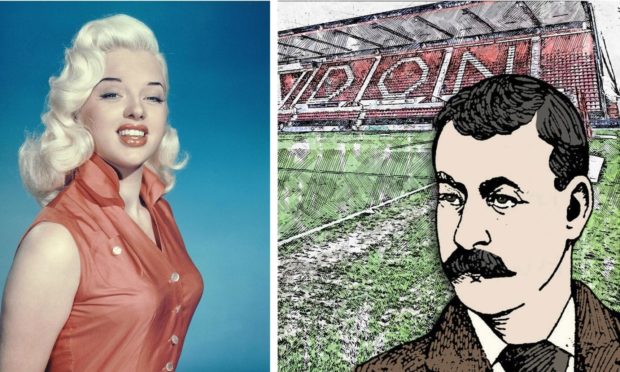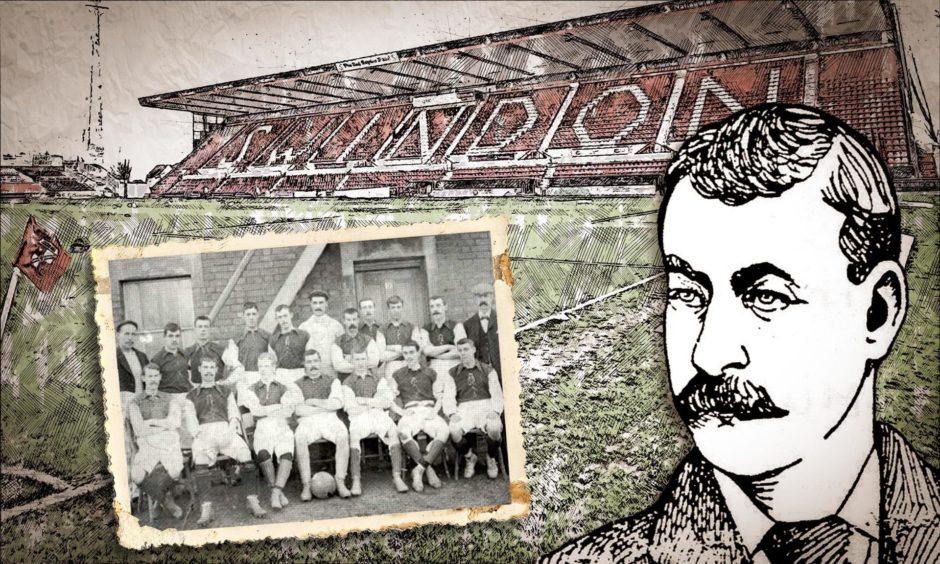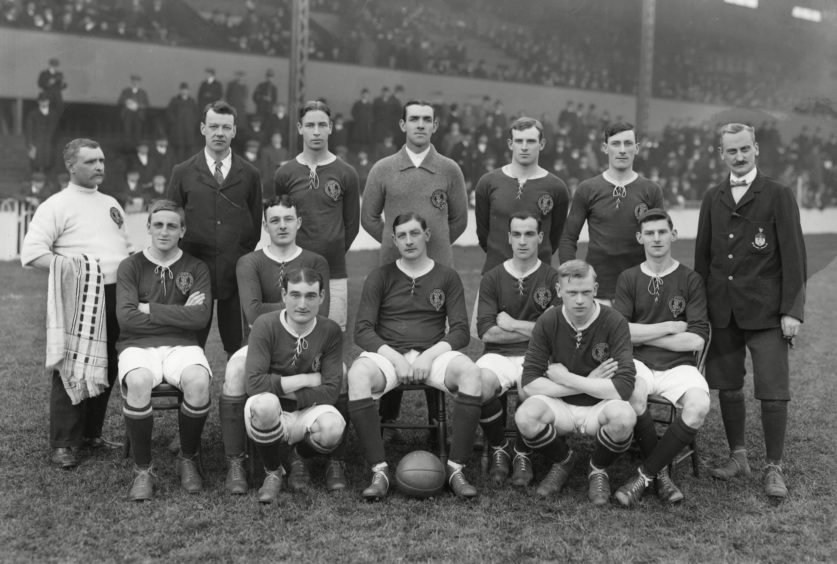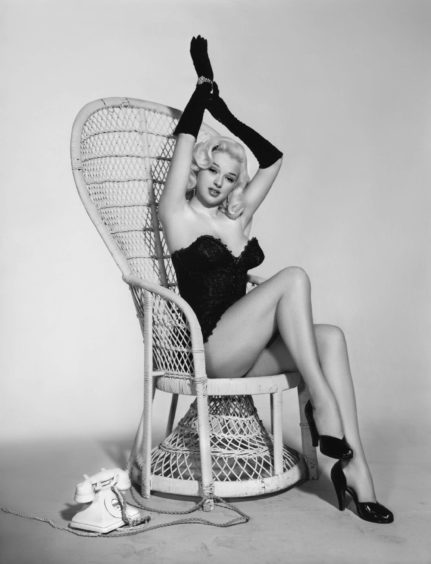Dundee-born footballer James Munro is set to join movie star Diana Dors in a blue plaque ‘walk of fame’ in Swindon.
Edith New, a votes for women campaigner born in 1877, was the first to get a plaque in 2016 after history group Swindon Heritage launched the scheme.
Screen siren Diana Dors who was known as the British Marilyn Monroe in the 1950s and former Swindon Town manager Sam Allen are among others recognised.
The Swindon Town Supporters Group and Swindon Town Trust now want Munro’s legacy to be marked with a blue plaque outside his old home in Kent Road.
Munro caught a cold as he led his Swindon Town side to a 4-3 victory over Tottenham on New Year’s Eve 1898 and days later he was dead at the age of 28.
Tottenham will always have a tragic link with Munro’s story and the team’s superstars have donated a signed pennant to the highest bidder.
The money would go towards the unveiling of the blue plaque.
Who was James Munro?
Born in January 1870, James Munro quickly rose from junior to senior circles and played for Our Boys before he joined Strathmore at the age of 17.
Munro played alongside Billy Dickson who won his only Scotland cap while with Strathmore when he scored four goals on his debut against Ireland.
Munro would follow Dickson to England, signing for Bolton in 1890 before a move to Burton Swifts in 1893.
Munro then joined Swindon in 1895 as centre-half and was given the captaincy after the club turned professional.
He played 93 games in all for Swindon and scored 18 goals, and won Southern League representative honours.
Thousands of people lined the streets to pay their respects when he was laid to rest but in the years that followed he slowly slipped out of the public consciousness.
Swindon Town supporter James Turner stumbled upon Munro’s story and tracked down his grave which had fallen into dilapidation following years of neglect.
Mr Turner organised fundraising efforts to raise £1,500 to restore the grave to its original condition and trace any surviving relatives in Dundee.
The full amount has now been raised and plans are now in place to start renovation work before a service is held to re-dedicate the grave.
Munro was a pioneer of the modern game
Thousands turned out to watch Munro’s final journey in 1899.
The funeral cortege left Munro’s residence in Kent Road and preceded to the Trinity Presbyterian Church which was headed by the New Swindon Town Military Band.
Among the floral tributes was one from his team-mates which bore the inscription: “Manfully he did his duty”, and the verse: “A star from out our ranks is gone; a light which shone the best; no more he’ll play the manly game, for Jimmy has gone to rest.”
“The full amount of £1,500 has now been received and the process will now start with the renovation,” said Mr Turner.
“Swindon supporters raised the money which is what I expected.
“Although Munro was born in Dundee he sadly died while he was playing with Swindon Town and therefore its our responsibility to maintain his grave.
“The renovation will be completed as soon as practical but the unveiling will happen when restrictions are back to a level of normality.
“We will be using newspaper cuttings from 1899 to replicate certain aspects of the funeral.
“An application by the Swindon Town Supporters Group and Swindon Town Trust will be made to the local blue plaque committee for James Munro.
“The blue plaque would provide a visible history to passers-by and ensure he will always be remembered.
“The plaque together with the grave renovation will also allow future Swindon Town supporters and historians to re-tell the story.
“Perhaps other clubs might see this as a method of remembering those pioneers of the modern game like James Munro.”
Munro family were living in Park Place in Dundee
Mr Turner said they are still hoping to locate a relative of Munro from Dundee to participate in the re-dedication ceremony at the graveside.
“The 1871 and 1881 Census showed the family living at Small Lane in Dundee,” he said.
“James was living in Bolton by the 1891 Census but his mother and some of the siblings were shown as living at 16 Park Place in Dundee in 1901.”
The directors paid Munro’s widow his full week’s wages following his death.
Munro was also included in the book Association Football & The Men Who Made It which is arguably the holy grail for any serious collector of football literature.
Alfred Gibson and William Gibson’s book is seen as the “indispensable work on the birth and development of football” and covers the sport’s Victorian origins.
The book described Munro as a “devoted servant” who was “without a superior” at centre-half in the Southern League and did “magnificent work for Swindon until death laid its chilly hand on him in the early part of 1898”.
Sam Allen and Harold Fleming are the only other two figures from Swindon Town’s history that have previously been honoured with a blue plaque.
Allen became the team’s first recognised manager in 1902 and maintained a secretarial position after standing down in 1933.
Overall, Allen is the sixth longest serving manager in the history of English professional football after managing the club for 31 seasons.
He received the Football League’s long service award in 1941, as he kept the club going during World War Two.
He died while still in office on January 1, 1946 after helping the team to win the Southern League title twice and reaching the semi-finals of the FA cup.
Harold Fleming made 11 appearances for England between 1909 and 1914, scoring nine goals and he made a total of 336 appearances, scoring 204 goals, for the Robins between 1907 and 1924.
There is a statue of him in the foyer at the County Ground.
Diana Dors was Britain’s answer to Marilyn Monroe in the 1950s
Diana Dors was Britain’s answer to Marilyn Monroe.
Both died young, leaving us wondering what they might have done in later years.
Diana was 52 when she passed away in May 1984.
She had been born Diana Mary Fluck in Swindon in October 1931, and it was Hamilton Gittins who promoted her as a kind of British Marilyn.
The young Diana was educated at Colville House, and even early on had a great liking for Hollywood stars like Veronica Lake, Lana Turner and Jean Harlow.
Diana soon became a phenomenon
So keen was she to get into this world of showbiz that she lied about her age, being offered a place at London Academy of Music and Dramatic Art at 14.
She starred opposite Richard Attenborough in Dancing With Crime, among other early jobs.
By 16, she had signed with the Rank Organisation, joined J Arthur Rank’s Charm School for young actors, and appeared in many of their films.
Diana soon became a phenomenon and with her abundance of confidence and glamour she was a welcome relief to the austerity of the war years.
Diana’s most celebrated role was in Yield to the Night (1956), in which she played a condemned woman in a prison cell.
When reflecting on her life in her autobiography Dors by Diana she exclaimed she “enjoyed the whole absurd mess to the highest possible degree”.














